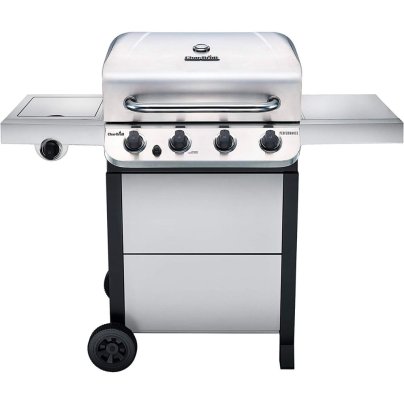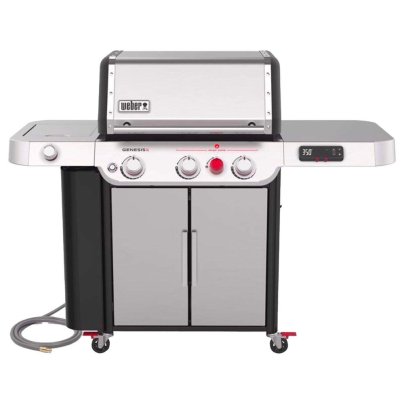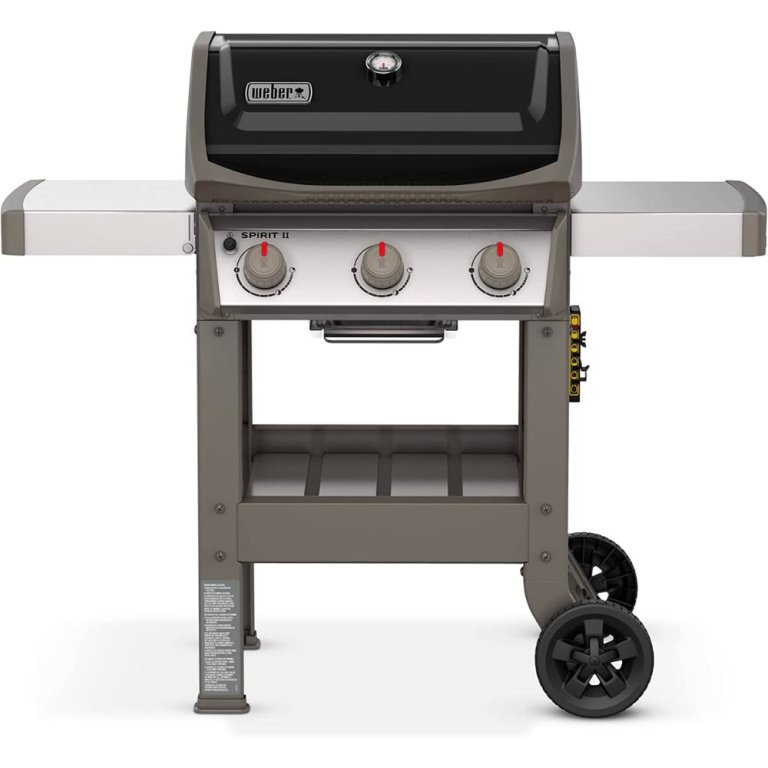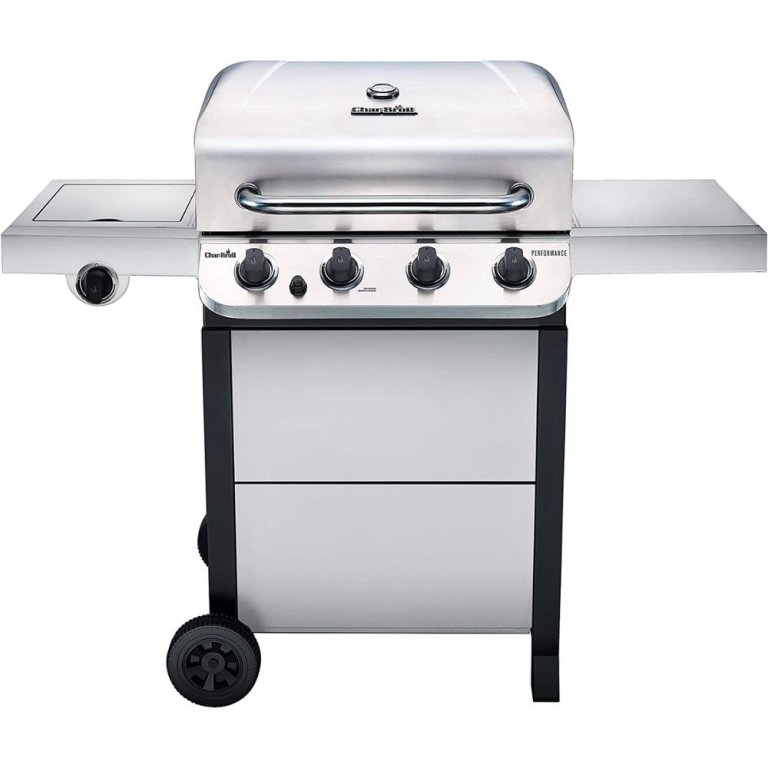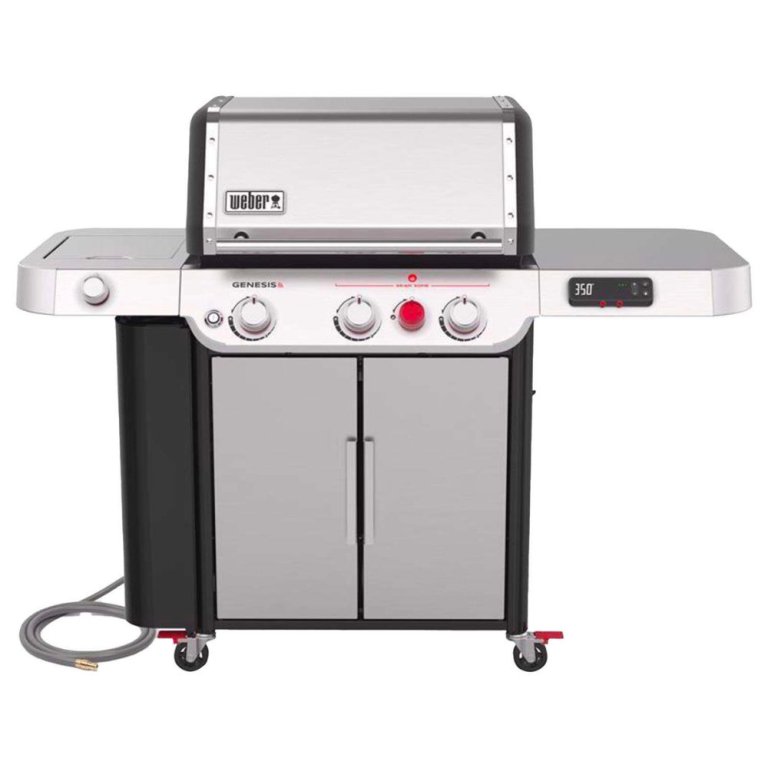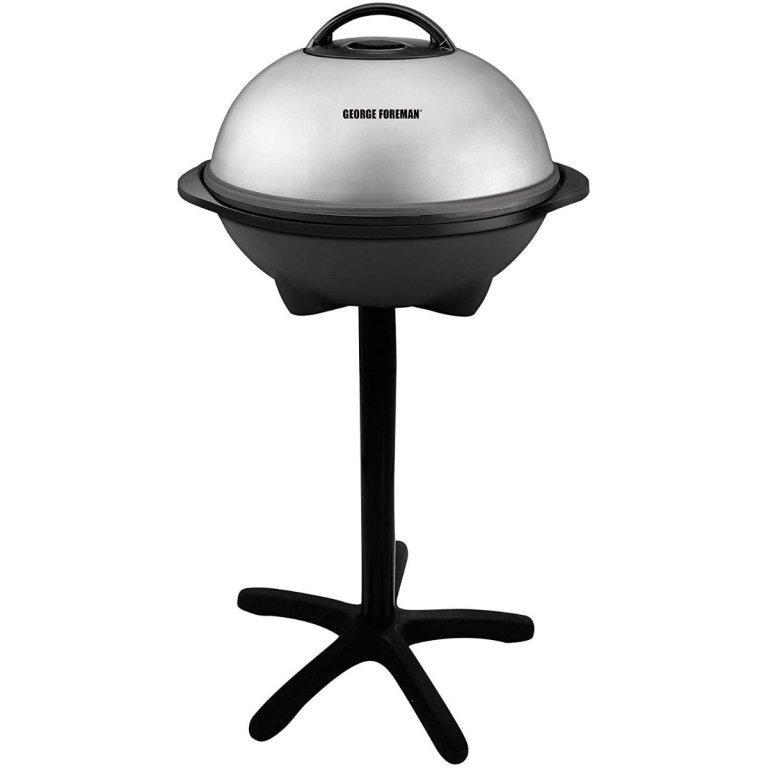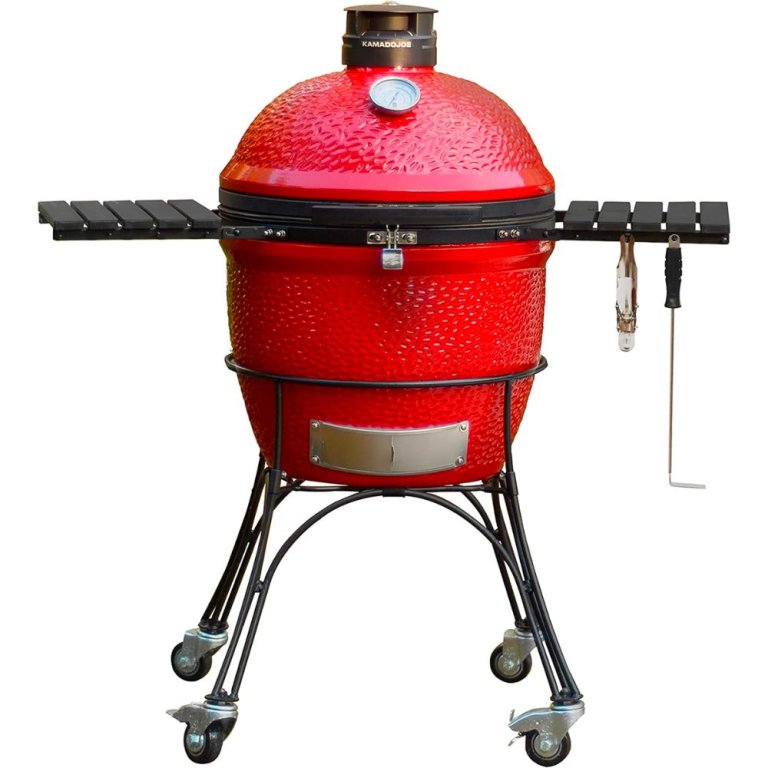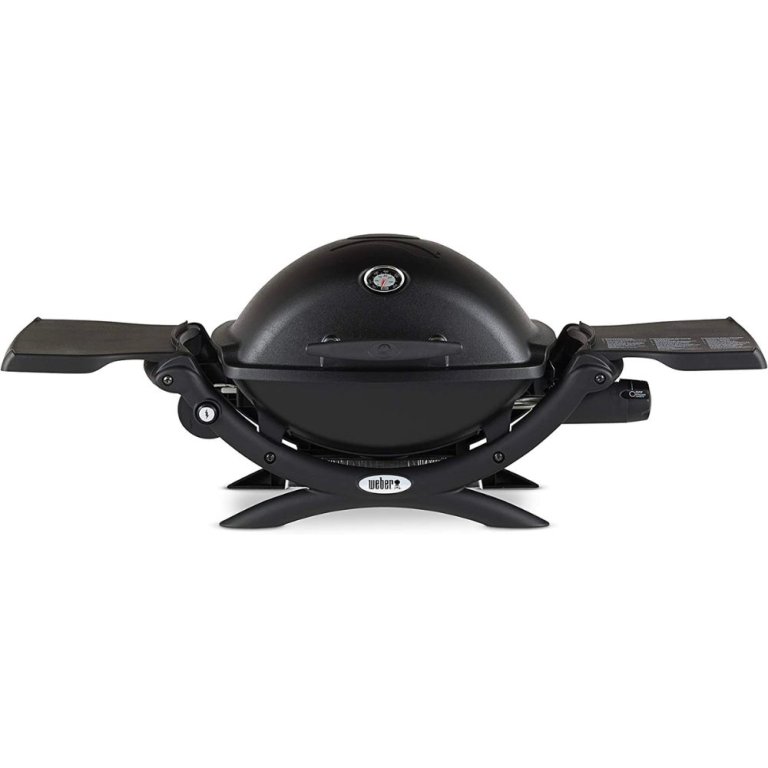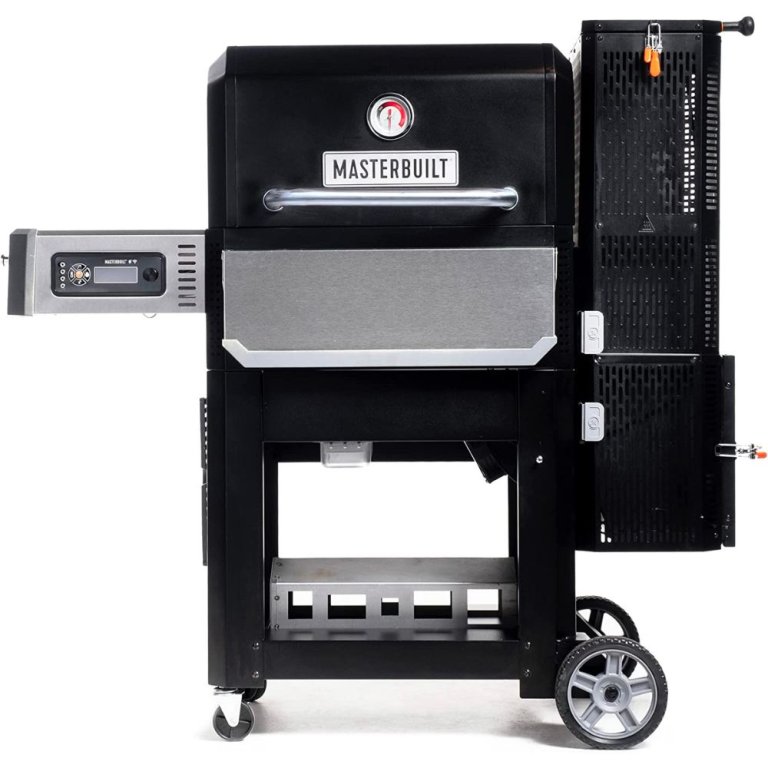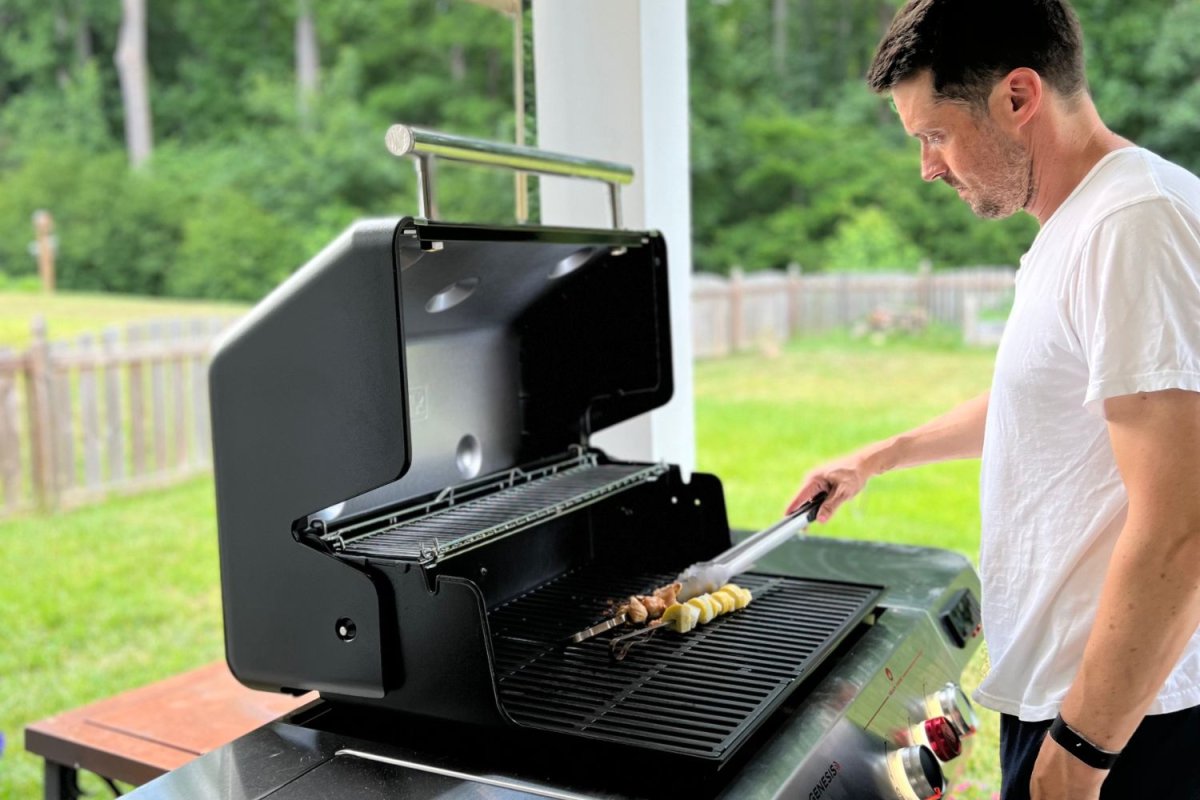
We may earn revenue from the products available on this page and participate in affiliate programs. Learn More ›
Head outdoors, put on some music, grab a drink, and fire up the grill. From simple burgers and hot dogs to steaks, kebabs, and ribs, a wide variety of meals can be prepared on a grill. Grilling can be a nice change from a routine and an enjoyable experience for many people, but the best part is often the delicious meal prepared for family and friends.
Gas and charcoal are the two most common fuel options for an outdoor grill, while electricity can also be used for both indoor and outdoor grills. While the fuel type is an important factor to think about when deciding on the best grill for your next get-together, there are more features to consider.
We conducted hands-on testing of dozens of grills of varying types and sizes to produce our list of some of the best grills on the market.
- BEST OVERALL: Weber Spirit II E-310 Liquid Propane Gas Grill
- BEST BANG FOR THE BUCK: Char-Broil Performance 4-Burner Gas Grill
- UPGRADE PICK: Weber Genesis EPX-335 Smart Natural Gas Grill
- BEST FLATTOP GRILL: Cuisinart CGG-0028 28-Inch Two Burner Gas Griddle
- BEST CHARCOAL GRILL: Weber Original Kettle Premium Charcoal Grill
- BEST ELECTRIC GRILL: George Foreman Indoor/Outdoor Electric Grill
- BEST KAMADO GRILL: Kamado Joe Classic Joe II Charcoal Grill
- BEST SMALL GRILL: Char-Broil Performance Series 2-Burner Gas Grill
- BEST PORTABLE GRILL: Weber Q1200 Liquid Propane Grill
- BEST SMOKER-GRILL COMBO: Masterbuilt Gravity Series 800 Charcoal Grill
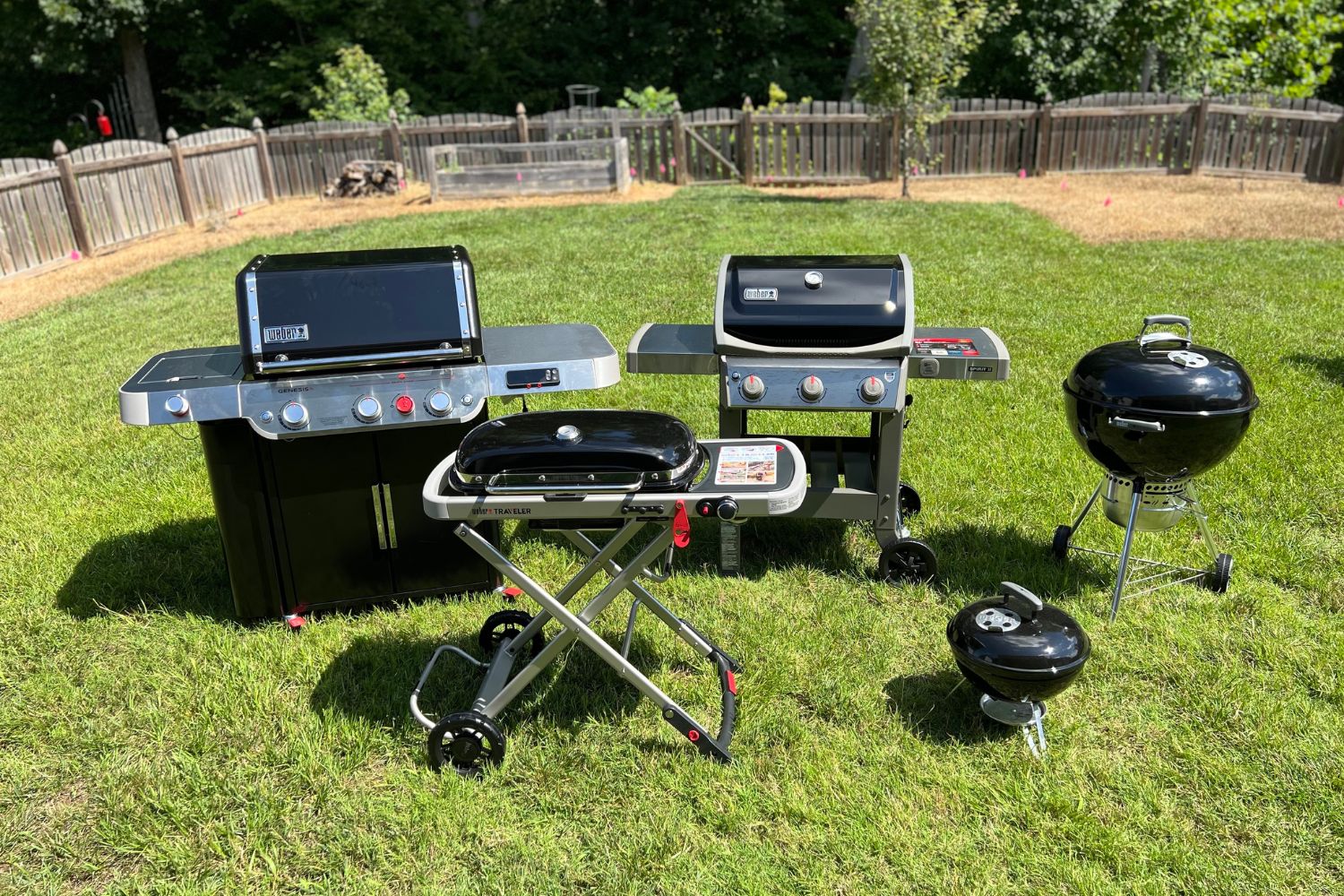
How We Tested the Best Grills
To create our list of the top grills, we assembled dozens of grills of all types, including gas, charcoal, electric, flattop, and kamado grills. During construction, we evaluated how easy each grill was to put together and also considered overall build quality. Once assembled, we tested each grill’s cooking performance by grilling chicken, steak, and burgers.
We noted each grill’s ability to both sear and cook food evenly while evaluating how easy it was to control cooking temperatures. We also tested additional features, including side burners, smart connectivity, sear burners, and smoker functions. After cooking with each grill, we noted how easy (or hard) each grill was to clean. Finally, we also took note of space for hanging and storing grill tools.
Our Top Picks
We chose the list of products below because they highlight grill options with durable construction, innovative design, and a range of different sizes and fuel sources. By selecting grills that consider these factors and those mentioned above, there’s sure to be a grill on this list that’s ideal for preparing food your whole family can enjoy.
Best Overall
Weber Spirit II E-310 Liquid Propane Gas Grill
Pros
- Sturdy construction with heavy-gauge sheet metal and durable enamel coating
- Includes attractive features, including flavorizer bars and optional smart control
- 3 burners create high temperatures for searing meat and vegetables
Cons
- Open cabinet design allows propane tank to be fully visible
- Does not include a side burner
Product Specs
- Type: Propane
- Cooking surface: 529 square inches
- British thermal units (BTUs): 30,000
The Weber Spirit II E-310’s exceptional build quality and performance make it the best all-around grill we tested. The Weber is rock-solid: Heavy-gauge sheet metal with a thick enamel coating give it a sturdier feel than many of the other grills we used. The Spirit II’s quality parts also fit together nicely—we didn’t experience any swaying or bowing while cooking. It also comes equipped with durable cast-iron grill grates.
The Spirit II E-310 features Weber’s GS4 cooking system, which is an impressive setup. It includes an electronic ignition, high-performance burners, flavorizer bars, and a grease management system. It also comes with two large side tables, and you can purchase a convenient app-connected thermometer if you so choose.
The grill starts with the push of a button, and its three burners register sear-worthy temperatures of around 550 degrees Fahrenheit. At such a high temperature, we had little trouble achieving grill marks on our test steak and burgers. The flavorizer bars (that seemed like a marketing gimmick to us at first) actually did make for more flavorful food by vaporizing meat drippings as they fell through the grate.
We did have a few gripes with the Spirit II, though. The propane tank is positioned on the side, meaning the tank is visible, and it also has no side burner. Overall, these are minor issues given the Weber Spirit II’s reasonable price, high performance, and durable construction. You would have a hard time finding a better all-around grill than the Spirit II E-310.
Get the Weber Spirit II E-310 grill at Amazon, Lowe’s, Ace Hardware, The Home Depot, Best Buy, or Weber.
Best Bang for the Buck
Char-Broil Performance Series 4-Burner Gas Grill
Pros
- Large cooking surface can handle a lot of food at once
- Can create multiple cooking zones with 4 burners
- Large removable tray under the burners makes cleanup easy
Cons
- Doesn’t get as hot as other gas grills
Product Specs
- Type: Propane
- Cooking surface: 425 square inches
- BTUs: 36,000
The Char-Broil brand is known for the value it provides with its line of gas grills. Among the many models it offers, this four-burner model is perhaps the best of the bunch. You get a lot at a price under $400, including 425 square inches of cooking surface. We were able to fit plenty of burgers, steaks, and kabobs on board while still having enough space between the food for flipping and turning. We also liked the four burners, which gave us plenty of options for creating multiple heat zones and grilling different kinds of food simultaneously.
There is a bit of a trade-off in power with the Charbroil. At 9,000 BTUs each, the burners were only able to get the cooking surface temperature up to 450 degrees Fahrenheit, which made it harder to achieve a good sear on steaks and burgers. It did, however, do a nice job of evenly heating the cooking surface at lower temperatures.
We loved the fact that the Char-Broil looks a lot more expensive than it is. It features all-stainless steel construction, with the exception of the frame, giving it an attractive overall look. We did find it odd that Char-Broil does not include any hooks for grill tools, and there’s no storage space under the grill. Also, the positioning of the propane tank leaves it partially exposed, which detracts somewhat from the grill’s aesthetics.
The Char-Broil does come with some nice extras, including a large warming rack on the interior and a side burner for cooking sauces and side dishes. We found the Char-Broil to be one of the easier grills to clean. The bottom tray slides completely out, making it easy to clean off drippings and food bits post grilling.
While the Char-Broil may not reach quite the level of performance of some of the pricier gas grills out there, the size of its cooking surface and handsome appearance make it an excellent grill for the money.
Get the Char-Broil 4-burner grill at Amazon or Wayfair.
Upgrade Pick
Weber Genesis EPX-335 Smart Natural Gas Grill
Pros
- 4 burners create very high surface temperatures for searing
- Large cooking surface can handle a lot of food at once
- Durable heavy-gauge sheet metal and cast-iron construction
- LED lighting for controls and cooking surface; ample storage space
Cons
- Takes up a lot of space at more than 5 feet wide
Product Specs
- Type: Natural gas
- Cooking surface: 787 square inches
- BTUs: 39,000
With its smart controls, advanced grilling features, and thoughtful storage design, Weber’s Genesis series of smart grills takes gas grilling to another level. For starters, the Genesis EPX-335 features significantly more cooking space than Weber’s smaller Spirit line of grills. This model boasts nearly 800 square inches of cooking surface broken up over three cooking zones. We found this to be ample space to grill hamburgers, kabobs, and steaks simultaneously at varying temperatures.
Weber gas grills are known for their high performance, and the Genesis didn’t disappoint. Thanks to its dedicated sear burner, we recorded surface temperatures of more than 700 degrees Fahrenheit, which was significantly higher than other gas grills we tested. Needless to say, this intense heat allowed us to sear a nice crust on our steaks and burgers.
What also sets the Genesis EPX-335 apart are its digital controls and smart capability. The control panel on the side burner allows you to monitor the grill’s temperature and includes multiple ports for smart meat thermometers. Once set up, we used the Weber Connect app to monitor the grill temperatures and digital thermometers as well as set timers and alerts.
The EPX-335 is also solidly constructed, with its heavy-gauge sheet metal, cast-iron hood, thick enamel coatings, and cast-iron grill grates. This grill is certainly built to last.
We also liked the control knob lighting and the built-in LED hood lighting that cast a bright light over the grill surface—both made it easier to grill at night. The EPX-335 has two side tables, which are notably larger than those on other grills. It offers ample storage in the grill cabinet and a side cabinet that opens under one of the side tables.
While the Genesis EPX-335 grill comes with a steep price tag, its outstanding performance, smart controls, and quality construction make it worth the cost.
Get the Weber Genesis EPX-335 grill at Ace Hardware, The Home Depot, BBQ Guys, or Weber.
Best Flattop Grill
Cuisinart CGG-0028 28-Inch 2-Burner Gas Griddle
Pros
- Quality construction with a rolled-steel cooktop
- More compact and portable than most full-size flattops
- Powerful burners heat cooking surface to high temperatures
- Grease management system makes it easy to clean
Cons
- Can be difficult to control heat when cooking at lower temperatures
Product Specs
- Type: Propane
- Cooking surface: 644 square inches
- BTUs: 30,000
A high-quality cooking surface and a surprisingly portable design make the Cuisinart the best all-around flattop grill we tested. The sturdy rolled-steel cooktop is powered by two 15,000-BTU burners, which heat the surface to temperatures above 600 degrees Fahrenheit. After seasoning the cooktop (a process that takes about 45 minutes), we used the dual-burner system to cook steak and chicken fajitas, and we loved the char we were able to get.
We really liked having two cooking zones to work with. We seared meat on one side while cooking our veggies at a lower temperature on the other. The Cuisinart also has two grease cups—a design that made collecting grease from the surface much easier than with the single grease tray most other flattop grills have.
Our only gripe was with temperature control. One of the advantages of a flattop grill is its ability to cook food you can’t cook on a grill, such as pancakes and eggs. With the Cuisinart, we found it a little more challenging to keep the temperature low enough to avoid overcooking these more delicate foods.
The Cuisinart’s 644 square inches of cooking surface is smaller than other full-size flattops; however, we didn’t feel limited, even while cooking for six people. In fact, we found Cuisinart’s smaller size to be an advantage. While most flattop grills fold up for transport, we found the Cuisinart more portable than most. At just 17.5 inches high by 28 inches long (when folded up), we found it much easier to load into the trunk of a car than other full-size flat tops. This small size makes it easier to store too.
With its compact size, quality construction, and excellent performance, the Cuisinart is a great all-around flattop grill, especially for those who may already have a gas or charcoal grill taking up real estate on their deck.
Get the Cuisinart grill at Amazon, The Home Depot, BBQ Guys, Wayfair, or Cuisinart.
Best Charcoal Grill
Weber Original Kettle Premium Charcoal Grill
Pros
- Doesn’t require a lot of charcoal to reach a high heat
- Ash management system makes it easy to dispose of used charcoal
- Vents on the base and lid help with temperature control
Cons
- Can be difficult to maintain lower temperatures
Product Specs
- Type: Charcoal
- Cooking surface: 363 square inches
- BTUs: N/A
Weber’s kettle grill design may be 70 years old, but that basic design continues to dominate the world of charcoal grilling. Among Weber’s collection of charcoal grills, its Premium model tops the list. It retains the classic kettle design while adding features that make it easier to cook with charcoal.
In terms of performance, the Kettle Premium is impressive. We filled our kettle grill to just a third of its capacity with charcoal briquettes, which was enough to reach extreme temperatures ideal for searing meat. In fact, the grill gets so hot that we found it challenging to get the temperature low enough to grill foods that prefer lower temperatures, such as chicken and veggies. In short, the Premium doesn’t require much charcoal to cook a lot of food.
While the Weber Premium may not match the cooking capacity of barrel-style grills, we found its 22-inch cooking grate large enough to handle a dozen or so burger patties. Weber includes some nice additional features with the Premium, including a hinged grate that allows you to add charcoal without having to remove the entire grate.
One of the biggest headaches of cooking with charcoal is disposing of ash. The Premium makes it easy with an ash control system that allows you to sweep the ashes into a metal container attached to the bottom of the grill. Post grilling, simply detach the container and carry it to the trash can to dump it. Other nice design features include a heat shield that keeps the handle cool to the touch even when the grill is blazing hot and vents for controlling temperature on both the top and bottom of the grill.
The Premium’s excellent performance, rock-solid build, and features that make it easier to cook with charcoal continue to make it the best all-around charcoal grill on the market.
Get the Weber Kettle Premium grill at Amazon, Lowe’s, Ace Hardware, The Home Depot, BBQ Guys, Best Buy, or Weber.
Best Electric Grill
George Foreman Indoor/Outdoor Electric Grill
Pros
- Cooking surface reaches temperatures hot enough for searing
- Grease management system and nonstick cooking surface are easy to clean
- Functions as both a stand-alone or tabletop grill when attached to the included stand
Cons
- Lid vent is more difficult to adjust than it should be
- Cooking surface does not heat evenly
Product Specs
- Type: Electric
- Cooking surface: 240 square inches
- BTUs: N/A
With its ability to convert from a capable outdoor grill to an indoor tabletop model, this version of the famed George Foreman grill is a great option for those who want the flexibility of grilling indoors or out. This model from the series of indoor grills named for the heavyweight boxer has a nonstick cooking surface with a large domed metal lid. It can sit on a tabletop or function as a stand-alone grill when the included stand is attached. We loved the versatility and simple design; we could install and uninstall the stand in seconds.
Given that the Foreman is limited to the amount of power it can take from a standard 120-volt outlet, we were impressed with its ability to heat its 240-square-inch cooking surface. We recorded temperatures of 525 degrees Fahrenheit, which was hot enough to sear a nice crust on our burger patty. We did notice that the heating was a bit uneven, with one half of the grill reaching higher temperatures than the other.
The nonstick plates made cooking easier and cleanup a breeze compared to other grills. Of course, a Foreman grill wouldn’t be a Foreman grill without grease management, and this model includes one. Holes in the middle of cooking grates send fat to a removable grease tray that sits under the cooking surface.
We also liked the dome-shaped lid, which did a nice job of creating a roasting environment for our chicken kabobs. The lid also has a vent to help control the temperature. Unfortunately, the vent on our lid was difficult to turn, requiring us to hold the lid with one hand while working the vent with the other.
Aside from this minor gripe, we liked Foreman’s version of an indoor/outdoor electric grill. It’s compact, lightweight, and performs surprisingly well for an electric grill, making it ideal for both kitchen and back patio use.
Get the George Foreman grill at Amazon or George Foreman.
Best Kamado Grill
Kamado Joe Classic Joe II Charcoal Grill
Pros
- Capable of reaching very high temperatures for searing
- Can cook in multiple ways, including grilling and smoking
- 2 large foldable side tables add valuable prep space
Cons
- Very heavy total weight makes it more challenging to assemble
- Design makes it more difficult to clean than a standard charcoal grill
Product Specs
- Type: Charcoal
- Cooking surface: 250 square inches
- BTUs: N/A
Kamado Joe’s Classic Joe II offers versatility not found with a standard charcoal grill. With its ceramic design, it can grill at very high temperatures of up to 750 degrees Fahrenheit for high-performance searing or maintain low temperatures of just 225 degrees Fahrenheit for low and slow smoking. You can also go beyond traditional grilling and smoking by purchasing accessories that allow the Joe II to make wood-fired pizza.
The Joe II is a formidable outdoor cooking appliance. When grilling, it produces intense heat over the grilling surface that dwarfs what one can achieve with a standard charcoal grill. We achieved a nice sear on our burgers and steaks, though the 18-inch size of the round cooking surface did limit how much we could grill at one time.
We like that the Joe II comes with an attachment that allows you to add a second-tier grill grate for smoking (though adding the second tier makes it difficult to access food sitting on the first tier.) The Joe II also includes two ceramic plates, which serve as a buffer between the hot coal and the grilling surface and create indirect heat for roasting chicken or smoking meat.
The Joe II has two vents, one at the base and one on the hood, which are effective at controlling temperature when smoking with the lid down. A hydraulic air lift on the hood makes it easy to raise and lower. There are also two fold-down side tables that are helpful for food prep.
We should note that assembling the Kamado Joe is no easy task, nor is it one that can be completed alone. That’s because the Joe weighs in at a whopping 231.5 pounds, with most of the weight coming from the single ceramic piece that makes up the body.
The Joe II, like most kamado grills, is an investment. Still, given its versatility, incredible performance, and durability (ceramic lasts much longer than sheet metal), it’s worth the money for those serious about grilling.
Get the Kamado Joe grill at Lowe’s, Ace Hardware, The Home Depot, or Kamado Joe.
Best Small Grill
Char-Broil Performance Series 2-Burner Gas Grill
Pros
- Compact size takes up half the size of other gas grills
- Attractive look with stainless steel hood and enclosed cabinet
- 2 powerful burners provide ample heat for the cooking surface
Cons
- Smaller cooking surface than other full-size grills
Product Specs
- Type: Propane
- Cooking surface: 300 square inches
- BTUs: 24,000
The compact size of Char-Broil’s smallest full-size gas grill makes it a great choice for smaller households or those who simply don’t have a lot of space on their deck or patio for a grill.
With the side tables folded down, the Char-Broil measures just 16 inches wide, about half as large as most full-size grills. It also sits on four casters, so it can be stored in a corner and then rolled out when it’s time to barbecue. With 300 square inches of cooking surface, the Char-Broil’s cooking area is notably smaller than other grills, but it’s more than capably supported by two 12,000-BTU burners.
Though the Char-Broil is small, we found it to be surprisingly mighty. It took just 10 minutes of preheat time for the cooking surface to reach 550 degrees Fahrenheit. Needless to say, we had no trouble searing our New York Strip steaks. And though its cooking surface is by no means large, it’s plenty of room to feed a family of four.
The Char-Broil also looks good thanks to the stainless steel hood and control panel and a cabinet that completely conceals the propane tank. Other nice features include a warming rank inside the grill and two large side tables that offer plenty of room for prepping food.
Get the Char-Broil small grill at Amazon.
Best Portable Grill
Weber Q1200 Liquid Propane Grill
Pros
- Compact size and simple design make it easy to transport and set up
- Capable of reaching high cooking surface temps for searing
- Cast-iron grill grates are easy to clean
- Fold-out side tables add valuable food prep space
Cons
- Single-burner design offers only 1 cooking zone
Product Specs
- Type: Propane
- Cooking surface: 189 square inches
- BTUs: 8,500
Weber is well regarded for its gas and charcoal grills, so it comes as little surprise that it makes perhaps the best portable grill out there. The Q1200 offers tremendous performance, a compact size, and a durable build, making it a great all-around portable gas grill.
In our tests, the Weber Q1200 started quickly and reliably, thanks to an electric ignition, and the cooking surface reached 550 degrees Fahrenheit, plenty of heat for searing a crust on our burgers. We were a little disappointed that it only has a single burner and hence one cooking zone, but we were impressed with its performance.
The Weber heats evenly as well. We loved the dome-shaped clamshell lid, which distributes heat nicely, allowing us to cook a thick chicken breast evenly. A built-in thermometer on the lid is also helpful. With a cooking surface of 189 square inches, the Q1200 offered enough space to cook six large burger patties. Most portable grills don’t have prep space, so we loved the fact that two shelves fold out from the grill’s main body, offering a surprising amount of room for food going on and coming off the grill.
From its cast-iron clamshell lid to its nonstick porcelain-coated grill grates, the Q1200 feels heavy-duty. We had no concerns about it surviving numerous tailgating outings or camping trips. In terms of portability, it’s light enough at 31 pounds for one person to carry. We were also able to fit it into our car’s trunk with plenty of room to spare. We should note that the Q1200 is a tabletop model unless you buy the stand, which is sold separately.
Get the Weber Q1200 grill at Amazon, Lowe’s, Ace Hardware, The Home Depot, Target, Wayfair, BBQ Guys, AJ Madison, Acme Tools, or Weber.
Best Smoker-Grill Combo
Masterbuilt Gravity Series 800 Charcoal Grill
Pros
- Digital thermostat makes it easy to maintain low temperatures
- Smart controls allow the chef to monitor temperatures and control the smoker remotely
- Large charcoal hopper holds enough charcoal to last for up to 12 hours
Cons
- Assembly is complicated and takes several hours to complete
- Doesn’t grill over a direct flame, making it difficult to sear
Product Specs
- Type: Charcoal
- Cooking surface: 800 square inches
- BTUs: N/A
The simple design of Masterbuilt’s Gravity Series 800 makes it a good charcoal grill and standout smoker. Its charcoal design creates ample heat for its main cooking surface, but it’s better suited for roasting chicken versus searing steak. That’s because it uses an offset design that produces even heat when the hood is closed. However, it doesn’t do as good a job of creating the direct heat required to sear meat.
While the Masterbuilt Gravity Series 800 is a very capable grill, where it really shines is as a smoker. Most charcoal smokers require constant attention from the chef to ensure that they maintain the proper heat to cook food slow and low. That isn’t the case with the Gravity Series 800. This smart smoker uses a digital thermostat that automatically regulates a fan to maintain the smoker temperature to whatever the chef dials in. During testing, we were impressed with how closely the Masterbuilt maintained the set temperature to within a few degrees.
We love the large size of the cooking surface, which spans some 800 square inches and made it possible for us to make enough food for a large backyard barbecue. In testing, we smoked several racks of ribs, a pork butt, and a whole chicken, all of which turned out juicy and flavorful with a distinct smoke ring.
We also found the smart controls and digital thermometers very helpful while cooking. The digital thermostat connects to a smartphone via the Masterbuilt app. Through the app, we changed the smoker temperature, monitored meat temperatures, and set timers. We also liked that Masterbuilt holds a whopping 16 pounds of charcoal, which meant we could let the smoker burn for up to 12 hours without having to refill it.
Though purists may not like the indirect heat for grilling, the Masterbuilt 800 is a very capable charcoal grill and a top-notch hardwood smoker.
Get the Masterbuilt grill at Amazon, The Home Depot, BBQ Guys, or Masterbuilt.
Jump to Our Top Picks
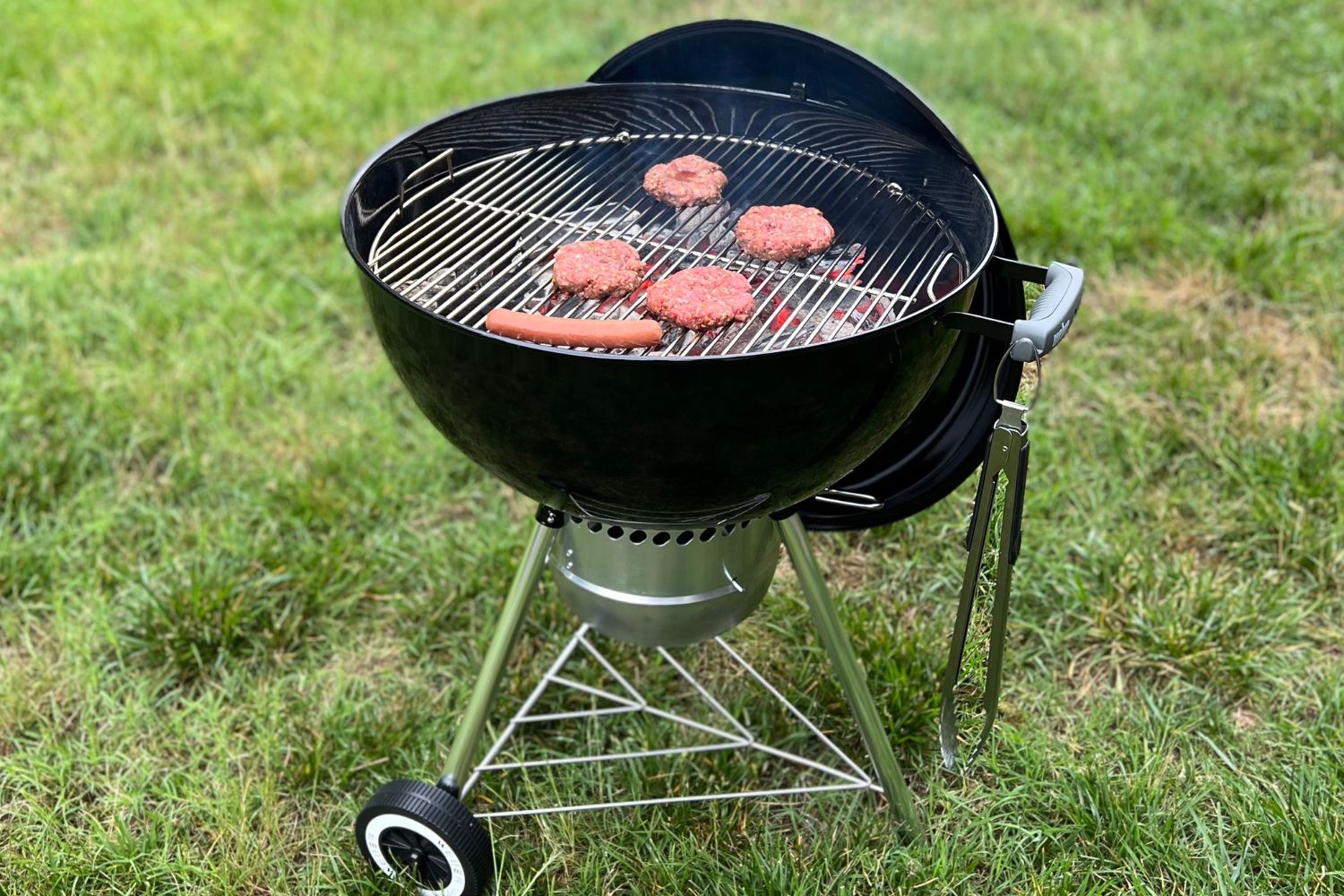
What to Consider When Choosing the Best Grill
When shopping for a grill to add to the patio, the deck, or an apartment balcony, consider several important factors. Determine the best type of grill and fuel source for the situation, but also consider the material, the cooking surface, the heat output, and a few additional factors detailed below.
Grill Power Sources
Grills can have several different types of fuel sources, each with its own benefits and limitations. The ideal fuel type can likely depend on personal experience with the various grill types, convenience, and preference.
Gas Grills
Many backyard grills are powered by propane gas, which typically comes in a refillable 20-pound tank. These grills feature burners, automatic igniters that fire up at a touch, and dials that adjust the heat. Propane grills offer serious power and heat up quickly. For many users, propane is the best gas grill type due to its fuel efficiency, convenience, and low initial cost.
Outdoor grills that run on natural gas are often designed for permanent installation in an outdoor kitchen, requiring connection to a natural gas line. Natural gas grills produce lower emissions and less exhaust compared to propane models. While they’re more expensive up front, the fuel is usually cheaper than propane.
Charcoal and Pellet Grills
The original outdoor fuel for grills is charcoal, usually in the form of briquettes. Charcoal grills offer the cook a high degree of temperature control—the more briquettes used, the hotter the temperature. This type of grill lends foods a distinctive smoky flavor that can be reminiscent of campfire cooking. They’re also some of the most affordable nonelectric grills.
Like charcoal grills, pellet grills impart a light smoky flavor to foods from the choice of hardwood. A fuel box holds the pellets and dispenses them automatically into the fire chamber to maintain a preset temperature for cooking. Since automatic dispensers run on electricity, an exterior outlet or an extension cord is needed to cook.
Electric Grills
Electric grills are usually lightweight, so they tend to be easier to transport. They are also suitable for apartment balconies because they don’t use potentially hazardous fuel sources like propane or charcoal. However, electric grills cannot typically produce the same high heat output as gas, charcoal, or pellet grills.
Electricity is the only acceptable fuel source when a grill is used indoors, so it’s expected that most tabletop grills operate on electricity. There are some electric grills that are made to be used both indoors and outdoors with the help of an extension cord. Some pellet smoker/grill combos also use pellets for fuel and electricity to connect to Wi-Fi in order for the smart grill to function properly.
Type
There is a wide range of grill types based on the method used to produce heat, the size of the grill, and the style. The types include standard, kettle, Kamado, smoker/grill combos, flattop, tabletop, and built-in grills.
- Standard cart-style grills typically have a square or rectangular base with a rounded, hinged lid. They have a main cooking surface and may have one or two heating racks above the main cooking surface.
- Kettle grills have a classic rounded shape and commonly run on charcoal. The grill is a steel chamber on legs that holds a charcoal grate and a cooking grate. A removable lid and vents at the bottom and top of the grill help control airflow.
- Kamado grills, also known as ceramic grills or egg-shaped cookers, take longer to heat up but will hold and radiate heat longer than a standard steel grill. They have a narrow egg shape that reduces airflow on food, so steaks stay moist while cooking.
- Smoker/grill combos can grill food at high temperatures in a short time or smoke food over low heat for hours to achieve a nice, tender result. Combining a smoker and grill into one device helps save space on a cramped patio or deck.
- Hibachi or flattop grills employ grates suspended over a rectangular metal chamber. The chamber of these smaller, more portable grills holds charcoal or one or more propane burners. Hibachis don’t have a lid, and while some charcoal models have ventilation in the bottom for heat control, this isn’t a standard feature.
- Tabletop grills, by design, have to be smaller than a typical backyard grill. They typically have a heat-resistant base or a set of legs to support the grill while protecting the table. These grills also may come with handles, a built-in tabletop stand, and a lid lock.
- Built-in grills are not portable; instead, they are installed as semipermanent fixtures in outdoor or indoor kitchens. These premium grills are built with tough construction materials such as brick, mortar, concrete, cast iron, tile, and steel. While they do require a significant initial investment of both time and money, they last much longer than standard grills.

Material
Grills can be made from several different materials, like powder-coated steel, ceramic, or stainless steel. The cooking grates also can be made with more than one material, including cast iron, stainless steel, and porcelain-coated cast iron.
- Stainless steel is a high-durability material typically used on a grill’s exterior, though a stainless steel grill may also have stainless steel grates or warming racks. It’s a lightweight material resistant to water, ultraviolet radiation, and impact damage.
- Powder-coated steel is not quite as durable as stainless steel, but it does enjoy a higher resistance to water, corrosion, and rusting. However, when the powder coating on the steel bubbles and chips, the exposed material will quickly degrade.
- Ceramic grills are ideal for high-humidity and rain-prone locations because ceramic grills cannot rust. Ceramic also has the benefit of heating up gradually and holding on to the heat for a longer period of time, making them great for long, slow cooking. Just keep in mind that ceramic isn’t as durable as stainless steel, and it is susceptible to chipping.
- Cast-iron grill grates retain heat well, and they can be seasoned to help protect the grates from water damage and corrosion. The cast iron transfers heat well, helping to provide consistent temperatures across the entire surface of the grill.
- Porcelain-coated cast-iron cooking grates are specifically made to protect the coated cast iron from water, corrosion, and rusting because porcelain is rustproof and has a high resistance to water and corrosion damage. However, as with powder-coated steel, when the porcelain begins to chip, the exposed material degrades rapidly.
Cooking Surface
When sizing a grill, the most important measurement is its total cooking surface. A small grill suitable for cooking 10 to 12 hamburger patties must have at least 300 square inches of cooking surface. A medium to large grill with 450 to 500 square inches of cooking surface will hold up to 24 hamburger patties.
Most backyard grills contain between two and four burners. Two burners usually offer enough space to cook a meal for up to four people. Three burners will serve around eight people. For bigger gatherings, large freestanding grills provide between four and six burners. Some built-in grills surpass that number, while tabletop models typically only have enough space for one burner.
Some grills come with attached side burners that will hold a small griddle or pot, which helps extend the cooking area. When it comes to grill size, it’s usually better to choose a bigger grill if there’s a desire to cook additional items, such as corn on the cob or shish kebab.
Heat Output and Control
Before deciding on a grill, find out how the temperature is controlled for that specific product. The heat output of a grill can be controlled in a variety of ways, depending on the type of fuel and grill.
- Standard gas grills typically have a simple dial to control the flow of gas, which increases or decreases the heat output.
- The heat output of a charcoal grill is controlled by adjusting the dampers to tailor the oxygen flow through the cooking chamber.
- Gravity-fed pellet smoker grills have an automatic feed system that ensures the temperature remains constant according to the setting entered in the digital control.
- Electric grills may only have an on/off switch instead of a temperature control dial. Any time the grill is on, it heats up to the maximum temperature possible for the device.
Weight and Portability
Grills range in weight from 10 pounds to more than 200 pounds, so there are many different sizes and shapes. If the goal is to be able to move the grill around a small patio or deck area, then all that’s usually needed is a set of wheels. Some grills have a pair of wheels at one end and a pair of feet at the other end, while others have four locking wheels that move the grill quickly across a flat surface.
Small lightweight grills may have folding legs that lock into place on top of the lid and double as a lid lock during transport. These products are great choices for a travel grill that’s made for going to the park, hitting the beach, or taking on a camping trip. There also are some flattop grills that have removable legs, so campers or tailgaters can disassemble the grill to pack it in the car.
Additional Features
Often, it’s the extras that make certain grills stand out from the rest. Some of the features included with today’s grills include the following:
- Infrared technology: Prized for uniform heat distribution, infrared technology is found in some higher-end gas grills. The gas warms a radiant heating element, which then radiates heat throughout the grill’s cooking chamber. Users report radiant heat offers a consistent cooking temperature, which can be desirable if you’re cooking a large cut of meat like a roast or baking a stone-pan pizza.
- Rotisserie: Some grills include a steel rotisserie bar for inserting through a large cut of meat or a whole bird, which is then suspended in the center of the cooking chamber. From the outside, manually rotate the meat as it cooks. Some have an automatic rotisserie that will slowly turn the meat.
- Griddles: If the preference is to enjoy a pancake breakfast outdoors, consider a grill that includes a griddle surface. Some grills feature only a large griddle surface (no grates), while others break up the cooking surface with both grates and a griddle.
- Built-in thermometers display the current temperature inside the grill. Using this simple reading, grill chefs can raise or lower the heat output so that food is prepared at the desired temperature.
- Warming racks increase the total cooking surface and give you a place to prepare foods that don’t need as much heat, such as buns. The racks also keep cooked food warm until it’s time to plate it.
- Side burners are an excellent addition to any grill, giving you more than one way to cook without running back and forth from the grill to the stove. A side burner uses the same fuel as the main grill, but instead of the grill grates, it’s equipped with a circular burner that’s great for a pan or a pot.
FAQs
Adding a grill to a home is a decision that creates new opportunities for creating so many different tasty meals. However, if you still have questions about your new grill, look below at some of the most commonly asked questions and their answers.
Q. Should I buy a charcoal grill or a gas grill?
Whether a charcoal or gas grill is right for you depends on personal preference, experience, and situation. Gas grills are easier to use, so inexperienced individuals who don’t want to learn something new may find these grills better than charcoal grills.
Experienced users and adventurous beginners may prefer the smoky taste of food prepared on a charcoal grill. The heat output on a charcoal grill is controlled by adjusting the airflow with top and bottom dampers that can be difficult to use.
Q. What should I look for when buying a grill?
There are many important considerations to remember when looking for a grill, including the type of fuel, grill type, heat output, heat control, weight, portability, material, cooking surface, and any additional features.
Q. How many burners do I need for my grill?
The size and shape of burners can differ among products, so instead of relying on a specific count, consider the area that the burner can heat. If a large grill has only one circular burner situated in the center, then it’s likely that the corners and sides aren’t receiving the same amount of heat. Evenly distributed burners throughout the grill ensure that the heat output is balanced across the entire grill surface.
Q. Can you use a regular grill as a smoker?
While a standard grill isn’t a good choice for smoking, there are smoker/grill combos that can prepare food by either smoking or grilling, such as the Traeger Pro Series 575 Grill and Smoker.
Q. Can a propane barbecue use natural gas?
No. Propane grills have smaller valves and orifices, so they won’t emit enough natural gas to reach proper cooking temperatures, and they may leak gas, causing a significant hazard to both the grill cook and anyone nearby. Stick to using natural gas for a natural gas grill and propane for a propane grill.
Q. How do you clean grill grates?
Grill grates are cleaned before and after every meal with a grill brush to remove any large pieces of food, burned sauce, and grease. Once per month, the grill grates should be scrubbed with a grill grate cleaner to remove any built-up grease, caked-on food, or burnt fat and carbon deposits.
Extremely dirty grill grates can be soaked overnight in a soapy water solution to loosen any stuck-on food and grease. However, keep in mind that oil can be used to protect some grill grates from water damage, so soaking is only advised for extreme circumstances.
Meet the Tester
Tony Carrick is a freelance writer specializing in home improvement, landscaping, technology, home security, and design. His articles have been featured on such sites as Angi, Popular Science, Futurism, 360 Reviews by U.S. News & World Report, Domino, and more. Carrick has conducted rigorous product testing on everything from power tools to home security systems to backyard grills. With each review, his goal is to help readers determine whether a product meets their needs and if it is or isn’t worth its price tag.
Additional research provided by Glenda Taylor and Timothy Dale.

